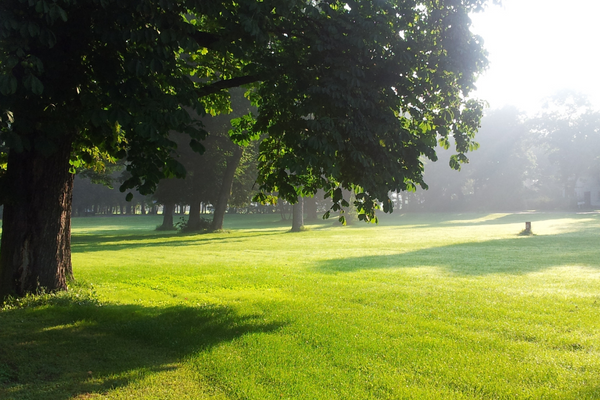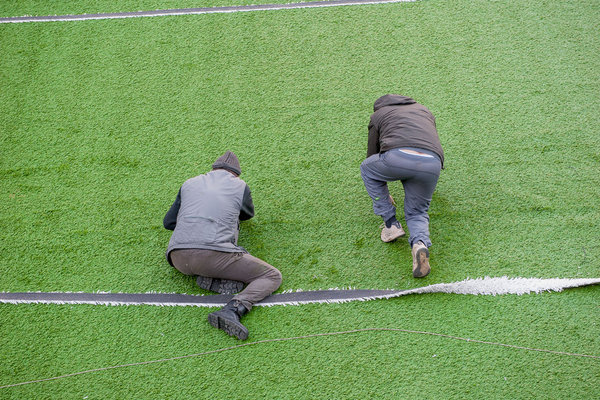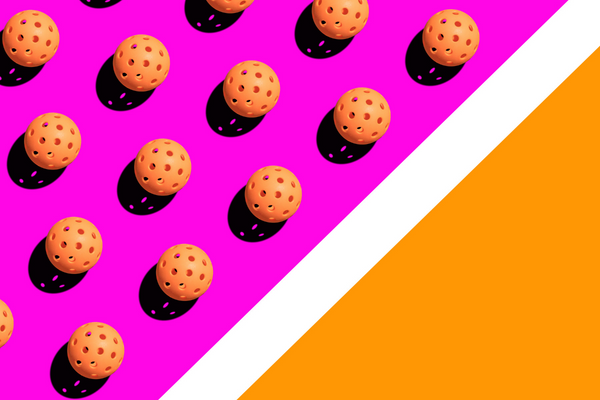If you’ve recently joined the leagues of pickleball players, you’re probably wondering whether you can practice at home. Can you play pickleball on grass, or do you need a tennis court?
While you can play pickleball on just about any surface, court variations affect playing style and game dynamics in different ways.
Grass courts are more difficult to play on since the ball doesn’t bounce well on the slippery surface. However, with some chalk or gaffer tape, you can set up your lawn as a temporary pickleball court.
Read on to learn more about how to play pickleball on grass, the problems you may run into, and how lawn pickleball varies from regular pickleball.
- Can You Play Pickleball on Grass?
- Where To Play Pickleball on Grass?
- Synthetic Grass vs Natural Grass
- Lawn Pickleball in the US
- Effect of Grass on Pickleball
- What Type of Pickleball Should You Use on Grass?
- Things To Consider When Playing Pickleball on Grass
- Sandy Pickleball – Birth of a New Sport?
- Conclusion
Can You Play Pickleball on Grass?
Yes, it is possible to play pickleball on grass, although there are several advantages to playing on a hard surface.
Grass surfaces don’t offer as much bounce as compacted surfaces. Often the ball may move erratically, making it difficult for beginners to predict its movements and react accordingly.
Additionally, your game’s quality is subject to several external factors like the weather and court conditions. For example, rain or morning dew can make playing on grass impossible. Similarly, playing pickleball in a park is a lot different from playing in your backyard. And outdoor tennis courts, despite having a grass surface, offer an entirely different experience.
These issues are not as critical for recreational players, however, for beginners intending to sign up for tournaments, the uncertainty of grass courts makes for poor practice. Overall, the inconsistency and unpredictable nature of grass pickleball make it harder than other forms of pickleball.
Where To Play Pickleball on Grass?

Now that you’ve decided to play pickleball on grass, what are your options?
1. Tennis Court
Tennis courts are the best surfaces to play pickleball on grass. Since the ground is hard, smooth, and compacted, it offers a solid bounce for your pickleball ball. Short of concrete or asphalt blacktop surfaces, a tennis court is a good place for an outdoor pickleball court.
Converting a tennis court into a pickleball court is extremely easy. All you need to do is move the net lower and use tape or chalk to mark out the court boundaries. If the court hasn’t been maintained, you can trim the grass to level the playing field.
2. Backyard
Playing in your backyard is not recommended because lawns are generally uneven surfaces. If your backyard isn’t leveled and completely flat, you won’t be able to play a proper game of pickleball.
That said, if you have enough space you can turn your lawn into a pickleball court. You’ll need to put up a temporary net and mark out the lines. Find a ball that is a bit heavier to overcome any bounce issues.
3. Park
Going to the park comes with a lot of the same challenges as playing on your lawn. But it’s easier to find a flat portion large enough to convert into a court. Plus if it’s in a busy neighborhood the park will likely be well-maintained and trimmed.
You can use gaffer tape to set up a temporary court and remove it when you’re done playing. Unlike chalk or acrylic paint it won’t leave any marks or residue.
Synthetic Grass vs Natural Grass
You can play pickleball on natural grass as long as it is trimmed and even. Certain spaces like outdoor tennis courts make better playing grounds than lawns or parks. The variation in the types of grass, its length, and maintenance make playing on natural grass unpredictable. The biggest risk is that the grass will be slippery, and your ball won’t bounce well.

Synthetic grass is a better option than natural grass because it gives you a solid and stable spot to bounce your ball off. At the end of the day, the more compact the surface is, the easier it is to play competitive matches. So if you want to play pickleball professionally or in a league try and find a court with synthetic grass.
Related: Can you play pickleball in the rain?
Lawn Pickleball in the US
Lawn pickleball is a huge phenomenon with hundreds of recreational players turning their homes into temporary pickleball courts. In fact, the US Lawn Pickleball Association even provides a detailed online guide on all the steps you can take to convert your yard into a proper pickleball court.
The first step is measuring out the appropriate court dimensions and marking the boundaries. Then you use paint, chalk, floor markers, or gaffer tape to make the lines. Finally set up your net 36 inches above floor level. While a standard pickleball court measures 20 by 44 feet you can always set up a smaller court when you’re playing at home.
Effect of Grass on Pickleball
The biggest issue with playing pickleball on grass is that the ball doesn’t bounce as high as it would on a hard surface. Generally, players use the bounce rate to estimate how close they need to stand to the net for solid return shots. But on a grass court, the ball moves erratically so you can’t predict its movement like you could on a tennis court.

Add to that other issues like pits, ditches, uneven surfaces, and slopes on your lawn. Depending on the weather conditions, rain, mist, or dew, playing on grass can become extremely difficult. Additionally, running on grass is harder than running on asphalt or concrete so it can mess up players’ reaction times in the game.
All in all, playing on grass is fine if you’re doing it as a fun recreational activity, but it can’t help you train for serious tournament play!
What Type of Pickleball Should You Use on Grass?
One strategy to overcome some of the effects of playing on grass is using a heavier ball. Generally, pickleball balls are made of soft plastic, and while this work well on hard courts, the lightweight material performs poorly on grass. A heavier rubber pickleball or foam ball will give you greater bounce on a grass field, despite factors like wind or dew.
Things To Consider When Playing Pickleball on Grass
Playing pickleball on grass comes with quite a few challenges. But with a few changes to the game, you can easily enjoy a few fun, recreational matches with your friends and family. Here are the top 10 things you need to keep in mind.
- Synthetic grass makes for a better court than natural grass.
- If you’re playing on natural grass make sure it’s freshly trimmed, compacted, and leveled.
- Grass tennis courts are better than parks, and parks are better than lawns. But if you’re in a jam you can turn your backyard into a temporary pickleball court.
- While the standard court size is 44 by 20 feet, you can always set up a smaller court for recreational play if you’re short on space.
- The pickleball net should not be more than 36 inches high at the sides and 34 inches towards the middle.
- Gaffer tape lasts the weekend but leaves no marks; chalk lines last longer; acrylic paint and vinyl floor markers are more permanent options for painting lines.
- Using a heavier foam or rubber ball instead of a lightweight plastic ball will help you avoid any bounce issues on the grass.
- Playing on grass will not prepare you for competitive, league matches because the ball’s movement is too erratic and unpredictable.
- If you want to play regular matches, you’ll need to trim your grass more often than you normally would.
- For players setting up courts if their backyards, putting in the work to fill up pits, ditches, uneven surfaces, and slopes can make all the difference.
Sandy Pickleball – Birth of a New Sport?

The pandemic gave birth to a lot of innovation as people struggled to come up with fun ways to spend their time at home. Sandy Pickle was one of these great ideas! Pickleball was modified so it could be played on grass or sand, depending on which players had access to. The rules are similar to traditional pickleball, but with a few changes.
- The court measurements are a lot smaller, with a width of 13 feet 6 inches, instead of the traditional 20 feet.
- Net height is adjustable, from 5 to 6 feet depending on whether you’re playing at the beach, the park, or at home. As a rule of thumb, simply set it to the height of the tallest player on the court!
- The “Kitchen” is replaced with the “No Spike Zone”, a 5-foot buffer area around the net. So, when you’re serving you have to do it from behind the No Spike Zone.
- Hit the ball in the air instead of letting it bounce.
- Overhead serves count, as long as you hit from behind the baseline. Just keep it out of the No Spike Zone.
- No changes in the scoring so games are won by a margin of at least 2, out of a total 11 points.
Conclusion
All in all, pickleball is a pretty diverse game. Can you play pickleball on grass? Absolutely! And if you’re playing it for fun then there’s no end to the modifications you can make. Whether you’re playing Sandy Pickleball or sticking to the traditional rules you can easily set up a temporary court at home or in a park.
